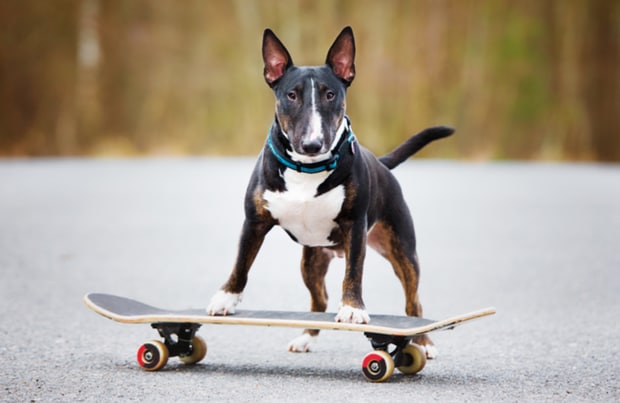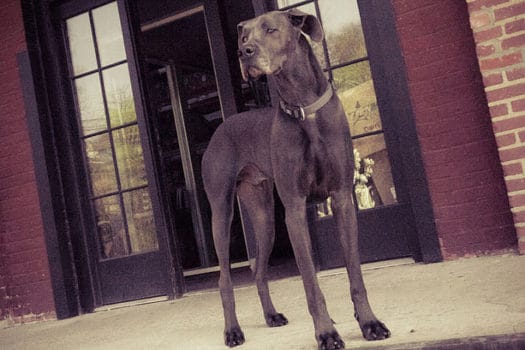If you’ve ever seen those videos of Tillman, the skateboarding Bulldog cruising down a street, then you know just how cool a dog riding along on a board can be. The trick might seem extremely difficult to teach, but with the right dog treats and a bit of patience, it’s something you can definitely teach to your pup. BeChewy caught up with professional skateboarder William Delago and dog trainer Aly DelaCoeur, founder of Why Does My Dog?, to get their tips on how to teach a dog to skateboard like an expert.
How to Teach a Dog to Skateboard Step-By-Step
Consider your Dog’s Breed, Age, and Athletic Ability
Before teaching your dog to hop on a skateboard, it’s important that you assess a few things. First off, you should make sure that the trick is something that your dog is physically able to do. DelaCoeur, for instance, has worked with her Pit Bull to hop onto the board but hasn’t encouraged her Lhasa Apsos to give it a whirl. “The Pit Bull has a very muscular back end, which makes him more sturdy on a board. But my other two dogs are tinier with funky knees. They could get hurt very easily and aren’t meant for that type of work,” she explains. While any dog can technically learn how to skateboard, Delago seconds the fact that certain breeds, like bulldogs, are better equipped for it than other breeds. Welsh Corgis, for instance, have legs that are too short to reach the ground from the board.
It’s also important that you check with your vet to make sure that your dog is in shape and healthy enough to handle a trick like skateboarding. And you definitely don’t want to put a nervous dog on a board. “You want a dog that has a go getter attitude. He might be a little nervous at first about the skateboard but ultimately he’s going to get over it and participate,” says DelaCoeur. “If you have a dog that is really shy and doesn’t want to approach new objects, don’t force him. It’s not worth ruining your relationship with the dog for a cool trick.”
Get Your Dog Used to the Skateboard
Before teaching your dog to skateboard, you have to make sure that he actually likes the physical board. Per our experts, you should first introduce the skateboard to your dog and make sure that he’s okay with being around it. “Let the dog sniff it, walk around it, and give him lots of treats and lots of praise,” DelaCoeur notes. Once he is used to the stationary board, begin to move the skateboard around a little bit in order to get the dog used to the fact that it’s not a stationary object. “For a lot of dogs, that’s when they get afraid of an object—when it moves,” DelaCoeur adds. Move the skateboard a little bit, give the dog treats when he pays attention and notices it.
Try a Stationary Skateboard First
For the next step, it’s important that the skateboard does not move. Place it in the grass or on the carpet to stabilize it or lock the wheels. “You want to get the dog to start getting onto the skateboard and you want it to stand still because if it moves while the dog is first learning to get on it, he might get scared and then never approach it again,” says DelaCoeur. “You can also try getting a dog to hop onto one of those aerobic stackable steps at first because they are about the same height as a skateboard but they don’t move.” The idea is to have the dog get used to the muscle memory required to step up onto something.
Stand behind the skateboard and have your hand over it with a dog treats by your pup’s nose. Slowly guide your pup towards the skateboard until he steps on it. And then once your dog steps onto the board, praise him for being on it. Give him high-value treats—like hot dogs, cheese, or boiled chicken—and ask him to stay. Then give your dog more treats for staying still.
Avoid rushing through this process. “You want to work at the dog’s pace. You don’t want to force him onto it and scare him. Depending on your dog, it might take five minutes, or it might take a couple of hours,” adds DelaCoeur. Do it over a couple of days and take breaks.
Moving the Skateboard With Your Dog
Once your dog is fully comfortable with being on the skateboard, slowly start moving the skateboard a little bit. “If he jumps off, it’s fine. That’s all part of the process,” says DelaCoeur. Repeat this step until you’re eventually able to move the skateboard quite a bit and the dog is still on it.
Teach Your Dog to Move the Skateboard
For this next step, Delago suggests attaching a leash or a rope to the board so that you have full control over it. He also notes that you should never leave your dog’s side while he’s standing on the board. “Once the dog is used to the motion of the board moving with him on top of it, have him put two paws on the skateboard and with your foot or hand, move the skateboard from side to side, just a little bit,” DelaCoeur explains. “The dog is going to have to learn how to move his weight so that way he’s moving with the skateboard.”
Next, slowly increase how much you are moving the skateboard so that the dog’s front paws are still on the skateboard, but now his back paws are having to push himself to move with the skateboard. From there, DelaCoeur says, slowly increase the distance until the dog realizes, “Oh. I can use my back paws to move the skateboard towards the treat.” And if your dog is not food motivated, DelaCoeur explains that you can use a toy or attention. “Eventually your dog will get that when ‘I move my back feet or front foot, the skateboard moves, I move closer to my human and then I get a huge reward at the end,’” she explains.
Safety Precautions When Teaching Your Dog to Skateboard
DelaCoeur stresses the fact that you should make sure to get a skateboard that coincides with the size of your dog. “My Pit Bull is 66 pounds, so he’ll need a little bit bigger skateboard versus if you’re having a Yorkie do it,” she explains. “You want to use a skateboard that is appropriate to your dog’s size so they can stand with all four paws comfortably on it.” Delgado says to never use a board that is smaller than 10.5 inches in width.
When teaching your dog to ride a skateboard, it’s extremely important that you do it in a safe and confined area. “You don’t want your dog starting this in a parking lot, rolling off and getting hit by a car,” warns DelaCoeur. It’s also important that when you do take the step to do it in your driveway or a park, that you keep yourself connected to the skateboard so that you are always in control of it. “Start off somewhere safe – even if it’s inside your house. Start off there and slowly work up to where you want to go,” says DelaCoeur.
The trainer also notes that you should pay close attention to your dog’s paws. If you have a dog that doesn’t go for long walks or isn’t very active, the pads on his feet might be really soft and the motion of pushing the skateboard can hurt them. “It’s important to keep an eye out for that,” she explains.
Teaching your dog how to skateboard is a really fun trick and can be a rewarding bonding experience for you and your pup. DelaCoeur says skateboard is also a great mental stimulus for high-energy dog breeds. “Teaching them to hop on a board will work them mentally,” she says. “If you have a crazy energetic dog, like I do, it is the perfect way to tire them out!”

Nicole Pajer is a freelance writer who lives in Los Angeles with her husband, energetic Doberman, and rat terrier.
Share:









